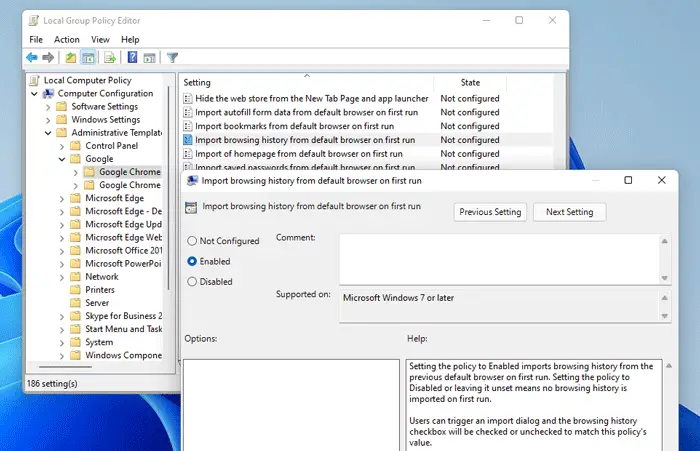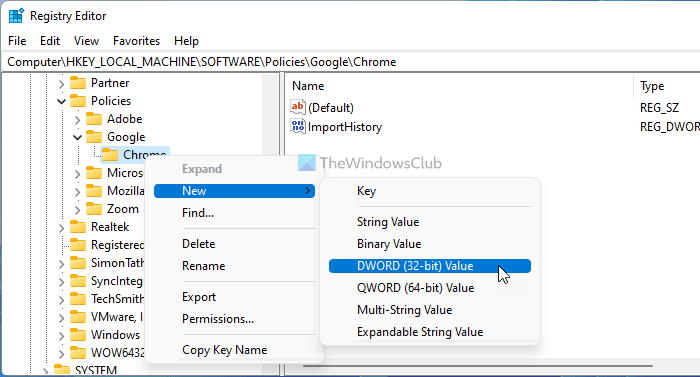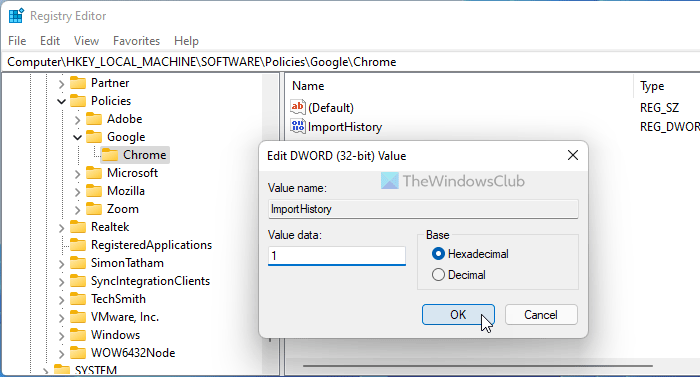If you want to import browsing history from the default browser to Google Chrome on the first run, here is how you can do that. Although it is possible to import data from another browser like Edge or Firefox to Chrome, this guide will help you get that done automatically. You can use the Group Policy and Registry Editor to set things up in your enterprise.
How to import History from default browser to Chrome on First Run
To import browsing history from the default browser like Edge or Firefox to Chrome on the first run, follow these steps:
- Press Win+R to open the Run prompt.
- Type msc and hit the Enter button.
- Navigate to Google Chrome in Computer Configuration.
- Double-click on the Import browsing history from default browser on first run setting.
- Select the Enabled option.
- Click the OK button.
To learn more about these steps, continue reading.
At first, you need to the Local Group Policy Editor on your PC. For that, press Win+R > type gpedit.msc and press the Enter button. Once it is opened, follow the following path:
Computer Configuration > Administrative Templates > Google > Google Chrome
Here you can see a setting called Import browsing history from default browser on first run. You need to double-click on this setting and choose the Enabled option.

Click the OK button to save the change.
Similarly, you can import autofill form data, bookmarks, homepage, saved passwords, and search engines as well. For that, you need to open the following settings and choose the Enabled option.
- Import autofill form data from default browser on first run
- Import bookmarks from default browser on first run
- Import of homepage from default browser on first run
- Import saved passwords from default browser on first run
- Import search engines from default browser on first run
As mentioned earlier, you can do the same thing with the help of the Registry Editor.
Read: How to force Chrome users to Sign in to use browser
How to import browsing history from default browser to Chrome on the first run using Registry
To import browsing history from default browser to Chrome on the first run using Registry, follow these steps:
- Press Win+R to open the Run prompt.
- Type regedit> press the Enter button > click the Yes button.
- Navigate to Google in HKLM.
- Right-click on Google > New > Key.
- Set the name as Chrome.
- Right-click on Chrome > New > DWORD (32-bit) Value.
- Name it as ImportHistory.
- Double-click on it set the Value data as 1.
- Click the OK button and restart your computer.
Let’s learn more about these steps.
To get started, press Win+R > type regedit > press the Enter button and click on the Yes button to open the Registry Editor on your computer.
Then, follow this path:
HKEY_LOCAL_MACHINE\SOFTWARE\Policies\Google
However, if you cannot find Google, right-click on Policies > New > Key, and set the name as Google.
Then, right-click on Google > New > Key, and name it as Chrome. After that, right-click on the Chrome key > New > DWORD (32-bit) Value.

Name it ImportHistory. Double-click on it to set the Value data as 1.

Click the OK button and reboot your computer to save the change.
Like the Group Policy method, you can also import other items using Registry Editor. For that, you need to create the following REG_DWORD values:
- ImportAutofillFormData: Import autofill form data from default browser on first run
- ImportBookmarks: Import bookmarks from default browser on first run
- ImportHomepage: Import of homepage from default browser on first run
- ImportSavedPasswords: Import saved passwords from default browser on first run
- ImportSearchEngine: Import search engines from default browser on first run.
How do I import browser history into Chrome?
To import browser history into Chrome, you need to follow the linked guide. Open the browser, go to the Bookmarks setting, choose the Import bookmarks and settings option. Then, select a browser you want to import data from, select what you want to import and click the Import button.
How do I Import Bookmarks, Passwords into Chrome browser?
To import Bookmarks, Passwords into Chrome browser from another browser open Chrome settings > Bookmarks > Import bookmarks and settings. Next you can select the browser from where you want to import the settings into Chrome. You can transfer settings from Microsoft Edge, Internet Explorer, Mozilla Firefox browsers or directly from a Bookmarks HTML file.
I hope this guide helped.
Leave a Reply